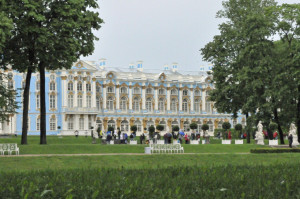Amber, the source of dinosaur DNA in Jurassic Park, is fossilized tree resin, created over millions of years. Most of the world’s amber, used to create orange/yellow gemstones, is mined near Kaliningrad, a Russian city on the Baltic known as Königsberg when part of Prussia. In 1701, Frederick I, the first King of Prussia, built a room in his Berlin palace lined with fragile panels of transparent amber, laid over gold leaf. In 1716, Tsar Peter the Great of Russia was so impressed that Frederick’s successor gave him the room to seal an alliance between Russia and Prussia. The Amber Room was eventually installed in Catherine’s Palace near St. Petersburg, incorporating additional amber panels from Prussia.
As Hitler’s troops neared St. Petersburg in 1941, workers attempted to conceal the Amber Room by covering the amber walls with paper. The German troops were not fooled and shipped the looted room to Germany, where it was reassembled in the Königsberg Castle. In 1943, with Allied troops advancing on Königsberg, the museum’s director was instructed to dismantle the Amber Room and ship it away. In August 1944, British forces bombed Königsberg, destroying the museum. The Amber Room vanished, with theories about its mysterious disappearance ranging from its being obliterated in the bombing to being hidden away somewhere in Germany. With the original Amber Room missing, Russian and German craftsmen spent 24 years and millions of dollars meticulously recreating it in Catherine’s Palace, where Vladimir Putin dedicated it in 2003.
In August 2015, reports surfaced that the Amber Room might be on a lost Nazi gold train, said to have been discovered in Poland. Stay tuned.

Comments are closed.